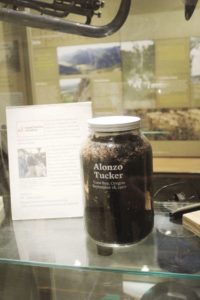As reservoirs decline on the Colorado River, California water agencies are under pressure to shoulder a substantial part of the inevitable cuts.
California water districts are under growing pressure to shoulder substantial water cutbacks as the federal government pushes for urgent solutions to prevent the Colorado River’s badly depleted reservoirs from reaching dangerously low levels.
California has the largest water entitlement of any state on the Colorado River, totaling 4.4 million acre-feet. The water flows to farmlands in the Imperial and Coachella valleys, and to cities from La Quinta to Los Angeles. Reducing the state’s use of the river could involve expanding drought restrictions in cities, increasing incentives for property owners to remove grass, and paying farmers to cut the amount of water they use to irrigate their fields.
Managers of districts that rely on the Colorado River have been talking about how much water they may forgo. So far, they haven’t publicly revealed how much they may commit to shore up the declining levels of Lake Mead, the nation’s largest reservoir.But state and local water officials say there is widespread agreement on the need to reduce water use next year to address the shortfall.
Without major reductions, the latest federal projections show growing risks of Lake Mead and Lake Powell approaching “dead pool” levels, where water would no longer pass downstream through the dams. Though the states haven’t agreed on how to meet federal officials’ goal of drastically reducing the annual water take by 2 million to 4 million acre-feet, the looming risks of near-empty reservoirs are prompting more talks among those who lead water agencies.
“Everyone agrees that we have to work together to take action to stabilize the Colorado River system,” California Natural Resources Secretary Wade Crowfoot said. “The status quo is simply untenable. We are looking at these reservoirs dipping below dead pool in coming years if we don’t come together to take extraordinary actions.”
Federal officials from the Interior Department and the Bureau of Reclamation recently met in Salt Lake City with water managers from the seven states that rely on the Colorado River. Some who attended the closed-door meeting on Aug. 26 said that the discussion was productive, and that Assistant Interior Secretary Tanya Trujillo and Reclamation Commissioner Camille Calimlim Touton expressed willingness to work with the states to develop plans for water reductions.
Though Trujillo and Touton have stressed their interest in collaborating on solutions, they have also laid out plans that could bring additional federal leverage to bear. Their plan to reexamine and possibly redefine what constitutes “beneficial use” of water in the three Lower Basin states — California, Arizona and Nevada — could open an avenue to a critical look at how water is used in farming areas and cities.
How the government might wield that authority, or tighten requirements on water use, hasn’t been spelled out. The prospect of some type of federal intervention, though, has become one more factor pushing the states to deliver plans to take less from the river.
The Colorado River, long overused to supply farms and cities, has shrunk during a 23-year megadrought that research shows is being intensified by the hotter temperatures unleashed by the burning of fossil fuels.
Farmers in parts of Arizona are already dealing with major water cutbacks under a 2019 agreement, and Nevada has also taken cuts. But California, which has more senior water rights, has yet to see reductions under that deal.
Tom Buschatzke, director of the Arizona Department of Water Resources, said in a letter to the federal government this week that Arizona supports various proposals put forth by Nevada. They include improving water efficiency in agriculture, creating a regional program to help people with the costs of removing grass, and redefining “beneficial use” to eliminate “wasteful and antiquated water use practices.”
It’s difficult to say what might qualify as “wasteful” or “antiquated” in any reexamination, but “beneficial use” is a foundational principle in Western water law, with accepted uses enshrined in state laws including categories such as municipal, industrial, irrigation, recreation and mining, among other things, said Rhett Larson, a professor of water law at Arizona State University.
Because most water rights fall under state law, developing a new definition of “beneficial” would be complicated and could lead to lawsuits, Larson said. What might qualify as “waste” would also be hard to pin down, he said, because “one person’s waste is another person’s job.”
“I think the average voter probably thinks of water waste as things like water-slide parks and golf courses and grassy medians in the road,” Larson said. “While I agree that we need to remove nonproductive turf … when I think of waste, I think about it more in the sense of agriculture, since that’s where we could get the most savings.”
Others are also looking to agriculture. Leading Nevada water manager John Entsminger has pointed out that roughly 80% of the river’s flow is used for farming, and much of that is for thirsty crops like alfalfa, which is mainly grown for cattle.
Larson said he expects the focus to be on requiring more efficient water use, such as shifting away from flood irrigation toward drip and center-pivot irrigation systems. In some areas, water seeps into the ground along unlined dirt canals and evaporates from open canals. Larson said lining these canals with concrete would make sense, as would eventually covering canals with solar panels to reduce losses to evaporation.
Arizona and Nevada are calling for a look at “wasteful” water use as a way of prodding large California agencies like the Imperial Irrigation District to agree to substantial cutbacks, Larson said. It’s an indirect way, he said, for the two states to send a message that “California, your agriculture needs to be more efficient.”
In June, Touton called for the states to come up with plans for major reductions within two months. But negotiations grew tense and acrimonious, and the talks didn’t produce a deal.
After the failure to reach an agreement, Entsminger criticized what he called the “unreasonable expectations of water users” and “drought profiteering proposals.” Sen. Mark Kelly (D-Ariz.) called for other states throughout the Colorado River Basin to “step up and do their part.”
The meeting in Salt Lake City apparently helped smooth over some of those tensions.
“By the end of the meeting, it was pretty warm and fuzzy,” said Bart Fisher, vice president of the Palo Verde Irrigation District’s board. “I thought it was Reclamation’s intent to try to really hit the reset button and get people working together again.”
The meeting helped create “some goodwill” among the parties, Fisher said, and “sets the stage for future discussions.”
Lake Mead now sits 28% full, while Lake Powell has declined to 25% of full capacity. Hot and dry conditions are forecast to continue across the watershed at least through the fall, and the reservoirs are projected to continue declining.
“For the next two or three years, we’re going to be right on the edge of dead pool in both of our major reservoirs,” Fisher said.
The Palo Verde Irrigation District supplies water to farmers around the town of Blythe, next to the river.
Fisher, a third-generation farmer who grows broccoli, melons, wheat and hay, said the risk that his community could entirely lose its water supply underscores the need for action.
“It’s very scary,” Fisher said. “If there’s no river, then you have no community.”
Fisher said he has heard from other growers in the Imperial Valley and Yuma, Ariz., that they are willing to make sacrifices and contribute by reducing water use.
The newly passed Inflation Reduction Act included $4 billion for drought response and conservation programs, and much of that money is expected to be used to pay farmers and others to voluntarily use less water. Farm groups have urged the Biden administration to quickly use the funding to implement a “voluntary, compensated water reduction program.”
Farmers in Fisher’s district have already been leaving some of their fields dry and unplanted in exchange for payments under a separate deal that has been keeping some water in Lake Mead while providing water for the Los Angeles-based Metropolitan Water District of Southern California. This year, Fisher said, about one-fifth of the farmland in Palo Verde’s territory is being fallowed.
Managers of California water agencies that rely on the Colorado River, including the Imperial Irrigation District, Metropolitan Water District and Coachella Valley Water District, have also been discussing proposals for reducing water usage.
Fisher said he’s confident California’s water districts will work out plans to take less from the river next year. And he said the door is open for more discussions with Arizona to “work together toward a solution.”
In some states, the approaching gubernatorial elections in November complicate the task of trying to negotiate plans for water cuts, Fisher said.
“I think there are many governors who don’t want to rock the boat within their domestic economy, because water curtailments will mean economic curtailments,” Fisher said. “I’m hopeful that once we get past the fall elections, that we will see more state cooperation.”
Crowfoot said he’s optimistic the states will come up with plans to help stabilize reservoir levels starting in 2023.
“All water users and all states recognize we have to come together on this,” Crowfoot said. “I also think it’s important that we act this year.”
Crowfoot said that while leaders of California water agencies are discussing the actions they’re prepared to take, state officials have been talking with their federal counterparts about how the $4 billion will be used. And one of their requests centers on the shrinking Salton Sea, which is fed by agricultural runoff in the Imperial Valley.
Officials with the Imperial Irrigation District have pointed out that water reductions will hasten the decline of the Salton Sea, where the retreating shorelines are releasing lung-damaging dust. They have demanded funding for projects at the lake that are aimed at controlling dust and improving shoreline habitat.
“We’re making the case that significant federal funding is needed at the Salton Sea,” Crowfoot said.
Federal officials have so far refrained from attempting to unilaterally impose water cuts on the states, an approach that could trigger legal challenges.
Instead, the Bureau of Reclamation has announced a series of steps that include developing conservation programs and studying whether “modifications” at Glen Canyon Dam could enable water to continue to flow at levels below “dead pool.”
Notably, the agency has also announced, among other things, that it plans “administrative initiatives” focusing on efficiency and “beneficial use” of water in farming areas and cities.
“Beneficial use” has long been broadly defined in state laws to encompass all sorts of existing uses, such as swimming pools, golf courses, flood-irrigation of farm fields and water flowing in dirt canals.
The message from federal officials now, according to participants who attended the meeting in Salt Lake City, is that they want to narrow the definition by the end of 2023 in ways that can secure water savings.
During negotiations two decades ago, federal officials raised the possibility of reexamining “beneficial use” with leaders of the Imperial Irrigation District while pressing for a landmark water deal called the Quantification Settlement Agreement. That 2003 agreement was negotiated to rein in California’s overuse of Colorado River water and led to the nation’s largest agricultural-to-urban water transfer, sending a portion of the Imperial Valley’s water flowing to cities in San Diego County and the Coachella Valley.
Peter Nelson, chairman of California’s Colorado River Board, said federal officials at the time raised the possibility of reexamining beneficial water use as a “stick” in the process, while there were “carrots” that encouraged the parties to reach a deal.
Now, if a voluntary conservation plan isn’t worked out and the federal government moves to narrow the meaning of beneficial use, Nelson said, it’s a “big question mark” what sorts of water use might be targeted.
“I believe that those types of determinations will face a number of hurdles, including legal challenges,” Nelson said.
“So it’s in all of our best interests to come up with a collaborative solution,” Nelson said, to stave off “an imminent crisis.”
Get Group Therapy
Life




